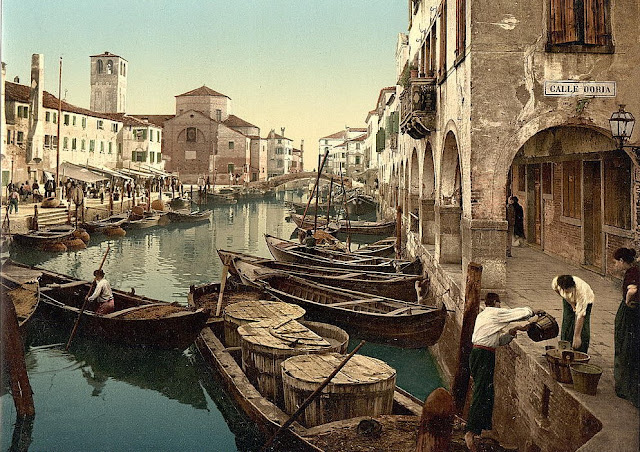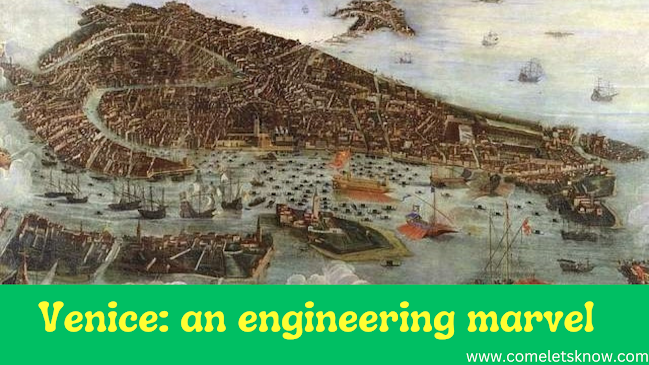The buildings and bridges of the floating city of Venice float on water with the help of wooden poles. From building a city on the sea by leaving an island to building it on wooden poles, why did the wooden poles not rot; There are different stories behind these.
Venetian architecture temporarily began in the fifth century.
In the fifth century the history of Venetian architecture begins. It was the period that marked the beginning of the decline of the Western Roman Empire. When barbarian and uncivilized nations from the north rose up to bring the former Roman territories and try to under their control. Brutal attacks on innocent residents and looting became commonplace.
Residents felt the need to build houses elsewhere to escape these attacks. They find it convenient to leave the land and build their dwellings on the swamps. The construction of the city of Venice began near the three sandy islands of Torcello, Jesolo and Malamocco.
Why was Venice built in the middle of water?
The inhabitants of the shores of the Venetian lagoon moved to the islands of the lagoon for their safety, When the barbarian attacks reached mainland Italy. Venice was the start of one of the world's most famous cities, while these unstable, marshy islets didn't seem like a good place to live. Today, Venice is known around the world for its intricate architecture and famous canals and hailed as an engineering marvel.
 |
| venice-Italy |
When the Venice began to take permanent form.
Although this construction was supposed to be temporary only to escape the barbarian attacks, gradually it began to take permanent form. Initially this work was confined only to the families of fishermen, i.e. those who had experience of both swimming and floating on water. But later it began to expand. In the beginning, because there were less people, lightweight houses were built with the help of some wood, straw and mud and used for living. But later the residents felt the need for a strong and solid foundation to handle the pressure of the large number of people in the temporary accommodation.
Read Jamestown: A Historical Overview
Day by day the reason for the arrival of people in these places was the attack of foreign enemies. It was difficult for them to invade the swamps. That is why gradually everyone decided to leave their habitat and live on the sea. A solid medium is needed to make the foundation of the dwelling strong and durable, and in this case wood is used by the inhabitants to fulfill this requirement.
Wood was the main component used to build foundations.
The work of building Venice begins by putting wooden poles, wooden planks one after the other. The only thing they could do during the time of distress was to gather wood to build a foundation. Moreover, these construction works did not have modern machinery. So wood became the main material for building their foundation.
Usually iron or any other solid medium is used as a foundation to construct a building or bridge. The point is, it needs a foundation that can take the load of the structure and not easily deteriorate in the long run. People who are used to using iron and concrete must be surprised to see such a construction on a wooden foundation. If nothing else, why the wooden poles are not rotting even though they are under water is a matter of thought. No decay was observed in the case of Venice.
Oak and larch wood were used in the construction of the city of Venice. Wooden poles about 60 feet long are replaced by hard underwater soft mud and rocks. Poles and planks made from the wood of these trees, which have been underwater for hundreds of years, hold the city's buildings in place. Naturally, the question arises how the wooden poles have survived for so many years under water? They are supposed to rot by now.
For more History releted blogs please visit www.blogger.com
In this case, the matter can be explained with some scientific reasoning. Decomposition of wood starts only when both water and oxygen are present in the environment. Oxygen is absent in deep seas or water bodies. If there is, it is negligible in amount. And that's why wood cannot rot even after being in deep water. As a result, the foundations of the city also remain strong. Moreover, the wood of oak and larch trees used in making the foundations is highly water resistant.
 |
| Chioggia fish market-Old Photo-Venice |
Building of the Santa Maria della Salute Church.
According to a book written in the 17th century, 11,06,657 wooden poles were used to build the Church of Santa Maria della Salute in Venice. Each pole was about 4 meters high. To build the church It took two years and two months. The process was quite difficult, so it was expected to take more time. Furthermore, wood had to be supplied from other places. And the wood was collected and brought by water. Most of the wood was brought from Slovenia, Croatia and Montenegro.
How did this foundation survive for so many years?
The city of Venice could not have survived if its foundations had been shaken or moved. The city has been able to pass this journey successfully. Deep in the ocean lies a layer beneath the sediment, which is made up of hard soil. It is called Caranto. The layer is made up of minerals in salt water. By placing the poles at this level, the foundation is also quite strong. Moreover, gravel, stones, and soil are constantly deposited at the bottom of the poles in the deep swamp, which strengthens the connection between the poles and the soil.
As a result, the poles become more durable instead of shifting day after day. Wood absorbed these sediments and became strong poles. And in this case the salt water of the sea has helped. The minerals in the water help strengthen this foundation.
This is the story of how the city of Venice was built. But the situation of the city surrounded by unique beauty is now deteriorating. Venice, a floating city built on wooden foundations, which is slowly sinking under water. The reasons for this are of course rising sea levels and global warming.
However, this is one reason why the traditional city of Venice does not have to suffer. There are more reasons. For example, constantly extracting water from deep in the soil. As a result, the mineral layer of the sea floor is moving further down. As a result, the foundation of the city is becoming weak. However, due to extraction of water deep in the soil, this risk is reduced, but the remaining risk remains.






No comments:
Note: Only a member of this blog may post a comment.